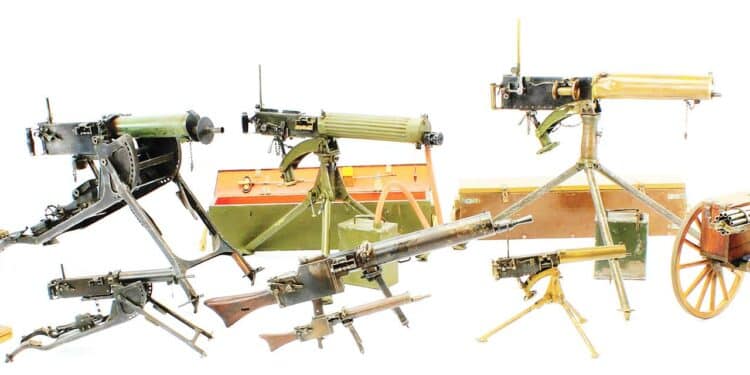Story & Photography by Robert G. Segel
This is the story of a gifted miniature arms maker whose masterful work of small pistols, rifles and machine guns were threatened to be destroyed by draconian gun laws in an Australian state after his death. The collection was spirited away under dark of night to another state and hidden by friends of the family. A lengthy process lasting decades to amend the laws to exempt the collection from destruction ensued and ultimately succeeded. In due course, the family then sold all the guns to a miniature arms dealer in the United States who then broke up the collection selling pieces to various miniature arms collectors. After nearly three decades since the collection was dispersed in the 1990s, the miniatures of his rapid-fire weapons have been reunited by a single collector. This is that story.
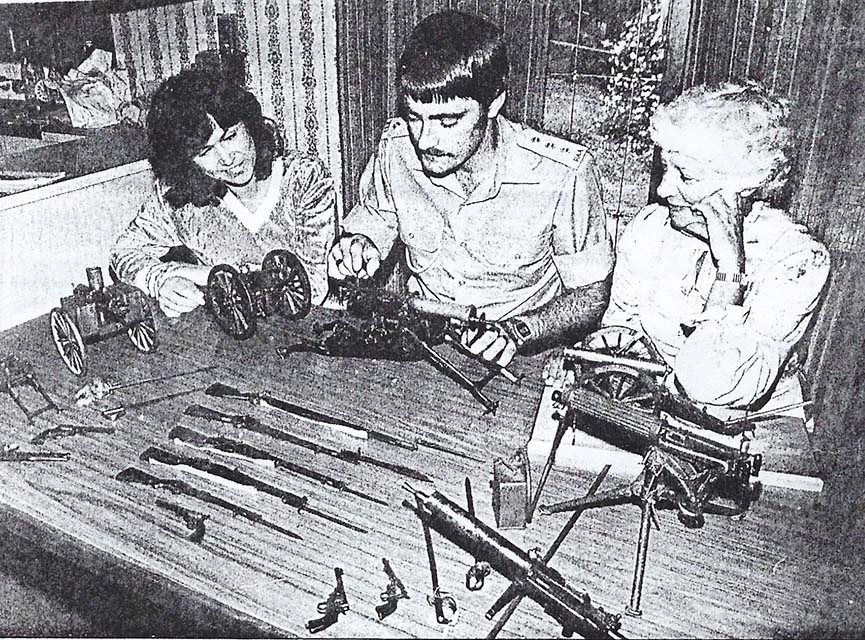
Frank Adlam
Frank Roland Adlam was a professional soldier for 32 years in the Australian Army. He specialized in artillery and tested guns and proofed ammunition for the Army and Navy.
The job took him to England on exchange with the British Army, and on his return in 1957, he worked at Port Wakefield (South Australia) where his expertise took him to the rank of Chief Warrant Officer Class 2 and Master Gunner, one of only two in the Australian Army at that time.
His interest in firearms was also his all-consum-ing hobby. While in England, he obtained original production tooling drawings for a variety of weapons used by the British Army during the 19th and 20th centuries, as well as textbooks, plans, specifications and other technical information.

Making Miniatures
After returning to Australia in a small radar hut at the Port Wakefield range, for the next 13 years Frank started to make miniature replica guns out of wood and then gradually incorporated metal into the guns so that they were completely authentic.
His creations include cannons in common use in the Napoleonic Wars (2), swords (4), pistols (6), rifles (7), Maxim machine guns (6), a Vickers machine gun, a 10-barrel Gatling gun and a five-barrel Gardner gun—some 30 miniatures in all. Most of his work was in 1/4 scale with a few items in 1/8 scale. The components of the guns were so small that he needed a range of machinery more like that used by a jeweler or fine craftsman. Much of the equipment he developed and made himself as he went along, because the pieces he was making were so small. Frank’s son, Ian, said. “All of the different skills he needed to produce the guns were self-taught. He became as good a draftsman, wheelwright, forger, fitter and turner and molder as you could find.” Like a watchmaker of old, everything was handmade. Even the more simple miniatures took about 200 hours to make, but the larger and more complex models, like the 1/4 scale Vickers machine gun took about 4,000 hours to make.
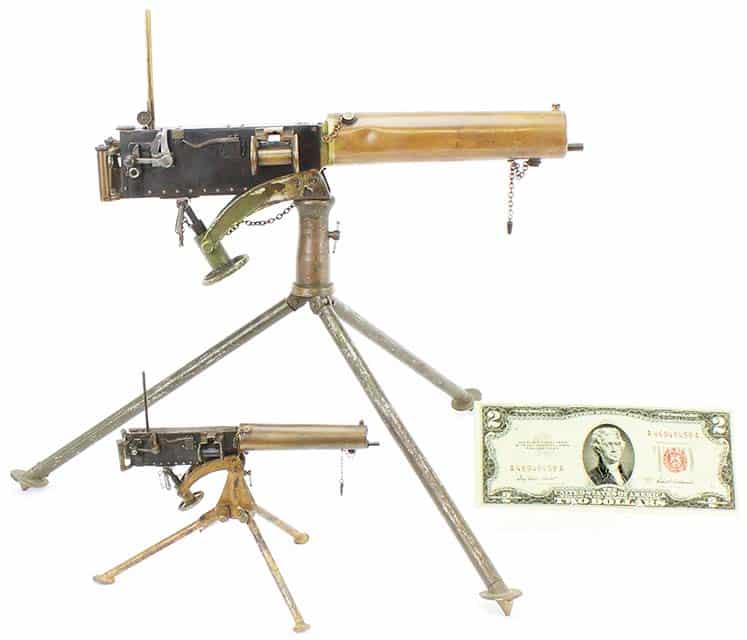
He displayed his work at many an event for nearly 15 years, drawing wide praise and attention. In 1970, he helped co-found the Antique and Historical Arms Association in South Australia. At one event a story emerged that Frank was having a discussion with another club member about how to correctly strip down a Vickers machine gun. Apparently, to the other’s astonishment, Frank produced the quar-ter-size miniature and went through all of the procedures on the spot.
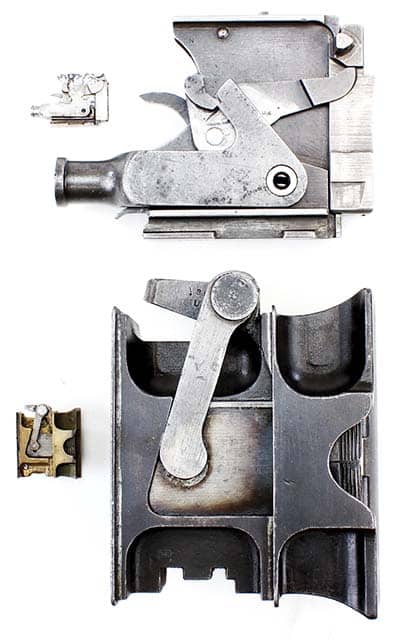
The Law
The very authenticity of the pistols, rifles and machine guns that Frank made created a large problem. Under the then existing state of South Australian laws, the guns were regarded as dangerous, illegal weapons and liable to be confiscated and de-activated by having the breeches and muzzles welded. This brought action by the South Australian police. Even though miniature, and no ammunition existed for them, if someone could make ammunition, the miniature could fire—even if only one shot. Warnings and citations were issued, confiscation loomed and legal action threatened. Unfortunately, Frank Adlam suffered a severe heart attack in 1972 that stopped his miniature making hobby entirely and curtailed nearly all his physical activity. (He died in 1982.)
Frank bequeathed his gun collection to his wife before he died, but the South Australian police and the law were presenting a very large problem for the family and then for the widow.
The president of the Antique and Historical Arms Association felt that the police action would amount to an act of desecration on what the Association regarded as unique and priceless works of art. Something had to be done until this could all be straightened out.
Weapons in Hiding
Suddenly, quietly and without notice, the col-lection was spirited away into hiding in another state. By whom, and to what state, nobody was talking. “Collection? What collection? I don’t know anything about the collection!” was what was told to the police. The word to the South Australian police was the collection just vanished. In the meantime, the Antique and Historical Arms Association took up the cause to try and have the law changed or amended so that the guns could be conserved and returned to the widow to sell, considering that would be a large financial benefit for her and her family struggling on a meager NCO pension. The guns were safe and in hiding in another state, but the years turned into decades. Nevertheless, the Association continued to lobby for an exemption in the law, and they had many supporters within the state and the legislature.
No Longer on the Lam
Finally, the Firearms Regulations Act of 1993 for South Australia was published, and in “Part B, Miscellaneous, Section 51” is the exemption of the Frank Adlam Collection. Found on page 28, the section simply reads: “Exemption of Frank Adlam Collection. 51. The miniature firearms that comprised the Frank Adlam Collection at the commencement of these regulations are exempted from the provisions of the Act.”
It took over 15 years, but the collection could come home to the family to finally do as they wish without legal entanglement or consequence. The family could now sell the collection for their financial benefit. The collection was sold to a dealer in the United States in 1994 /1995, and the collection was broken up as collectors picked up miniatures in their area of interest.
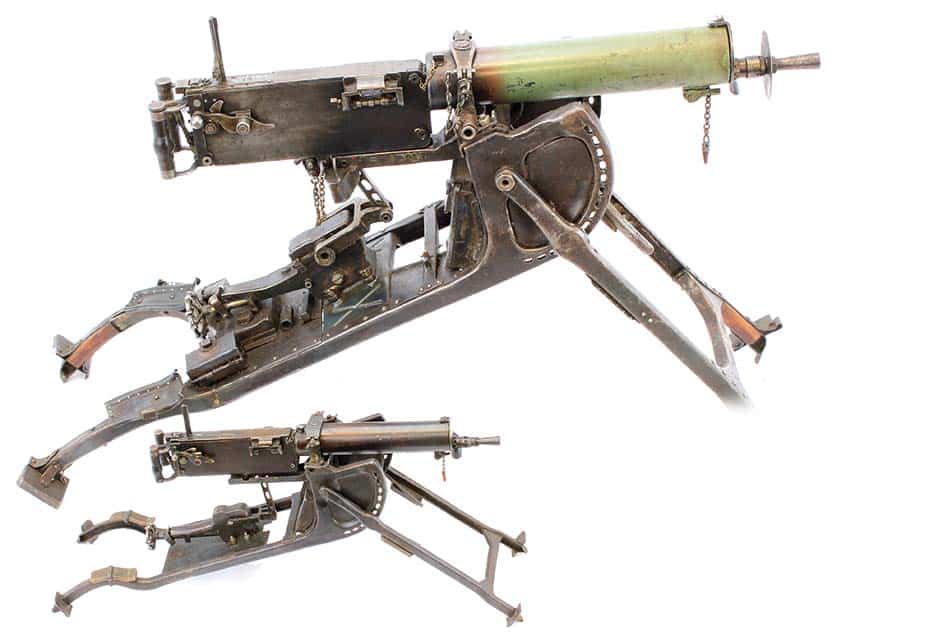
Rapid-Fire Weapons
As mentioned previously, Frank Adlam’s rap-id-fire miniatures included machine guns and a manually operated Gatling gun and Gardner gun. More specifically:
● Vickers .303 with tripod, water can, steam condensing hose and transit chest with cleaning rod. 1/4 scale.
● Maxim World Standard .303 with tripod. 1/8 scale.
● Maxim World Standard .303 with tripod, water can and transit chest. 1/4 scale.
● Maxim MG 08 on sled mount. 1/8 scale.
● Maxim MG 08 on sled mount. 1/4 scale.
● Maxim MG 08 /15 with bipod. 1/8 scale.
● Maxim MG 08 /15 with bipod. 1/4 scale.
● Ten-barrel Gatling gun in wheeled carriage. 1/8 scale.
● Five-barrel Gardner gun on naval mounting on decking, pattern 1897. 1/8 scale.
The 1/4 scale Vickers, brass water jacket early Maxim, MG 08 and MG 08 /15 were sold to a collector on the East Coast. The 1/8 scale brass water jacket early Maxim, MG 08 and MG 08 /15 were sold to a collector in the Mid-West. The Gatling gun and Gardner gun went to a collector in the South.
The collector in the Mid-West valiantly sought to bring the collection of rapid fire weapons together once again. It took 20 years, but he was able to first acquire the Gatling and Gardner guns and then, finally, the 1/4 scale machine guns from the collector on the East Coast. At last the miniature rapid-fire weapons that Frank Adlam so painstakingly hand-made some 50 years ago, were together again.
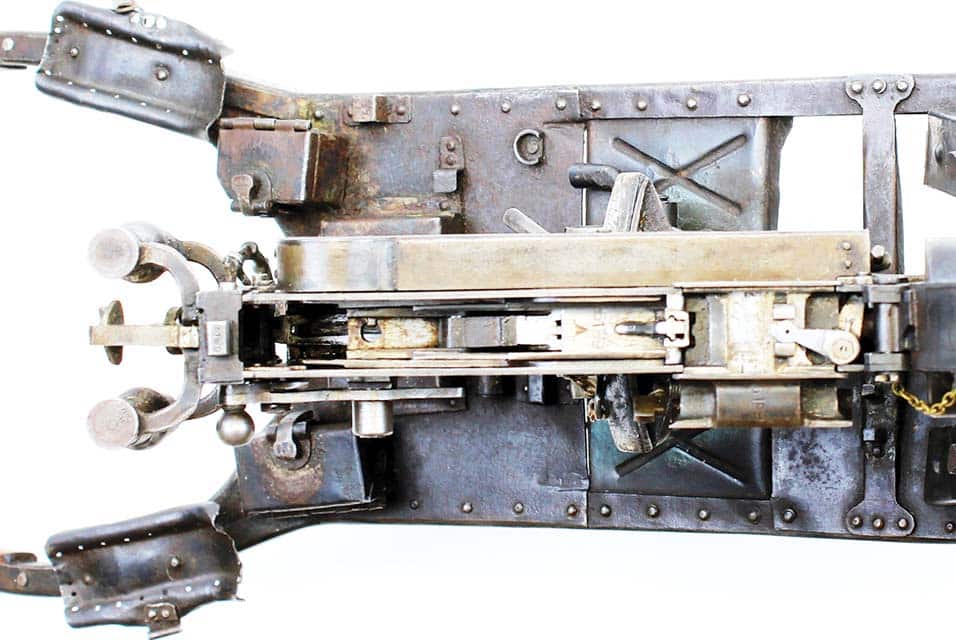
The Guns
The scale and depth of accuracy of all the guns are quite simply phenomenal. Remember that these were literally hand-made in the 1960s with simple tools and machines; no computer-aided design (CAD) machines or high-tech milling machines. These are not toys nor were they ever meant to be. These are indeed works of art that require a high level of skill as well as a deep knowledge of the subject.
Bare in mind that as the scale gets to the tiny 1/8 size, some things may have to be changed. The 1/4-scale machine guns have fully functioning locks whereas the 1/8-scale guns, due to their diminutive size, do not have functioning locks.
.303 Vickers Mk. I
1/4 Scale
The .303 Vickers Mk. I has the fluted water jacket with non-armored muzzle booster. The rubber steam condensing hose is affixed to the steam port and ends in a period-style gasoline can that was typically repurposed as a water can for machine guns. The gun is mounted on the Mk. IV tripod with operating elevation and traversing mechanisms. All internal components are present and work as they would in a full-sized gun, and the rear sight is fully operational. The Vickers comes with a transit chest with the proper scaled rope handles on each end and the correct style of closure latches. Affixed to the inside of the top lid is a cleaning rod. The gun measures approximately 10 3/4 inches long and stands 8 inches high on its mount.
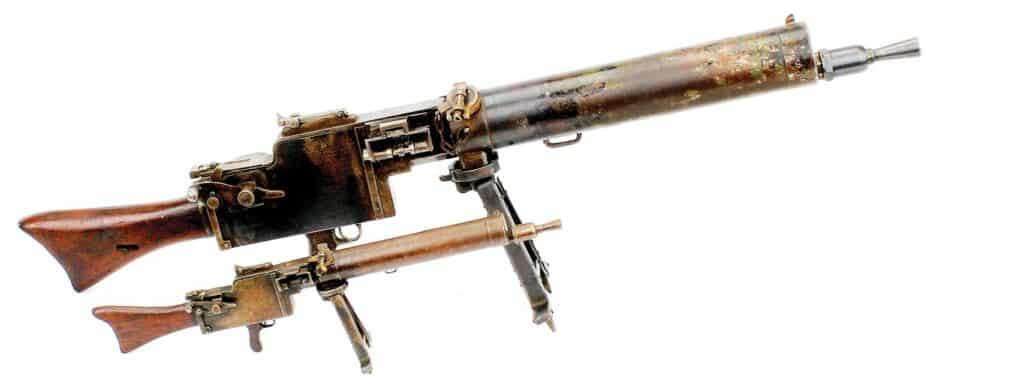
“World Standard” Maxim
1/4 and 1/8 Scale
Frank Adlam made the brass-jacketed “World Standard” Maxim machine guns in two sizes. This pattern of Maxim gun is recognized by its brass water jacket, large belt roller assembly on the feed block, the ear-ly-style, flat-faced crank handle and the brass hand grips. The fusee cover is also brass and is marked, “NO 2104, WT 58 LBS, MAXIM NOR-DENFELT PATD 1885.” The 1/4-scale gun is fully functional and mounted on a Mk. IV-style tripod cradle and a simplified commercial tripod. Included are a period-style water can and wood transit chest. The 1/4 scale gun measures approximately 11 inches long.
The 1/8 scale “World Standard” Maxim is identical to its larger 1/4 scale brother except it does not have an operating lock, though the crank handle does move and is under spring pressure from the fusee spring. The gun is mounted on a traditional later model Mk. IV tripod. No water can or transit box was made for this scale gun. The 1/8 scale gun measures approximately 5 1/2 inches long.
German Maxim MG 08
1/4 and 1/8 Scale
It is apparent that once Frank Adlam had all his measurements figured out, the challenge was to make the same gun in two different sizes while maintaining the appropriateness of the scales. Obviously, while the larger size provides the means for great detail, the smaller it gets and the harder it is to maintain that detail.
The 1/4 scale German Maxim MG 08 is mounted on the World War I era sled mount. The gun has the appropriate muzzle booster, flash hider and blast hider as well as the armored plate to protect the front of the water jacket. The rear grips are wood and have the oil brushes in the handles. All internal parts operate as the original. The top cover of the gun is marked “45189, MG. 08, D.W.M. Berlin 1918.” Additionally, the feed block is marked “5189,” and the top cover latch is marked “89 D.W.M.” Internally, the lock is marked “5189.” The sled mount is also fully functional in that the front legs move and lock to adjust height. The elevation mechanism works by turning the rear handle to elevate or depress the weapon. Traverse is controlled by the traverse bar and its lock and traverse stops. Details on the sled mount include spare barrel holder, spare parts box, oil and solvent containers, mountings for the angled chamber cleaning jag and the cartridge tongs and two spare lock containers. The gun measures approximately 12 inches long and sits 8 3/4 inches high on the sled mount.
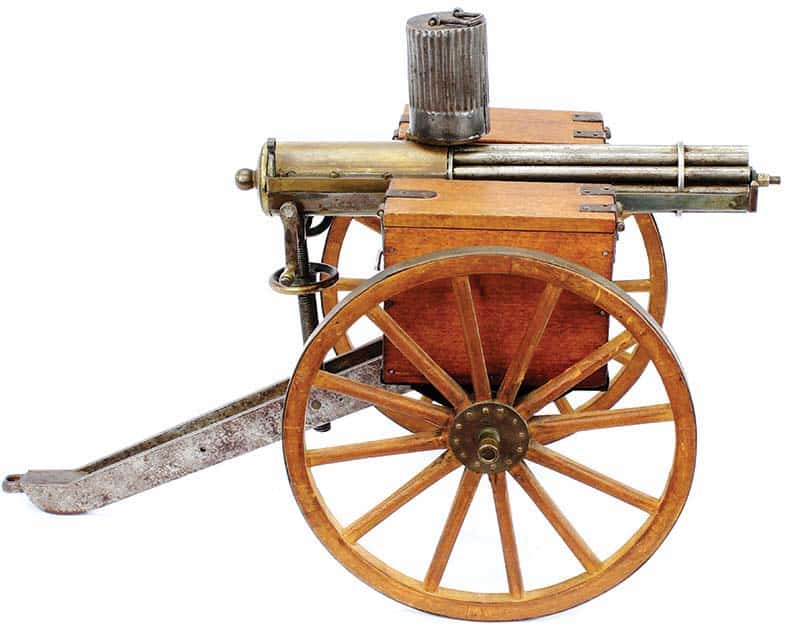
The smaller 1/8 scale MG 08 Maxim has the exact same exterior appearance and attention to detail as its big brother but does not have an operating lock, though the crank handle moves and is under spring pressure from the fusee spring. There are no markings on this miniature. Due to the size, some of the details found on the 1/4 scale sled mount are not found on the 1/8 scale sled mount. While it does have movable front legs and the rear elevation mechanism is fully functional, there is no traverse bar. Additionally, while there are two spare lock boxes, no other mount accessories are present. The gun measures approximately 6 inches long.
German Maxim MG 08/15
1/4 and 1/8 Scale
The 1/4 scale German Maxim MG 08 /15 is accurately portrayed with the proper muzzle booster and flash hider, top-mounted water/steam hose connecter and removable bipod. Markings include “2106” on the top cover and “MG 08 /15 1917 Spandau” on the fusee cover. The internal mechanism works as in the original. The gun measures approximately 14 1/4 inches long.
The 1/8 scale German Maxim MG 08 /15 is also scaled to perfection though there is no internal lock, but the crank handle does operate under spring tension from the fusee spring. Markings on the top cover read, “6547 MG 08 /15 GWF Erfurt 1917.” The gun measures approximately 7 1/8 inches long.
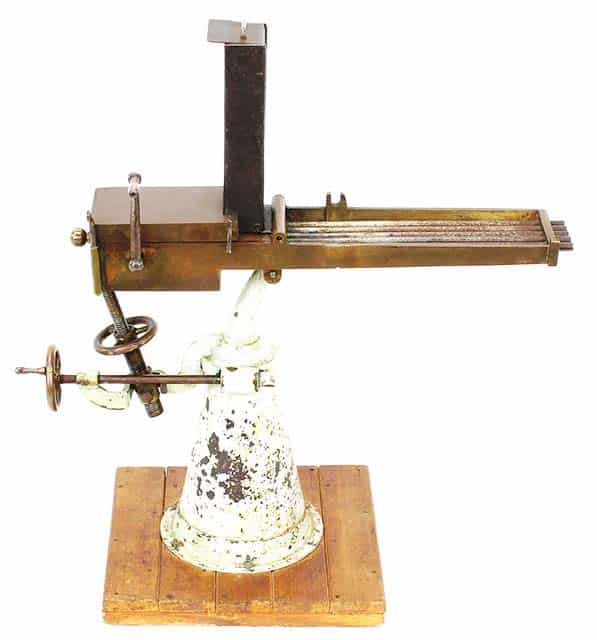
Gatling Gun
1/8 Scale
Broadwell drum magazine is mounted on a wheeled artillery carriage with wood magazine storage boxes to each hold two Broadwell drums. Elevation and traversing wheels work, and the crank handle rotates the 10 barrels. The gun measures approximately 7 inches in overall length. The barrels measure 4 inches, and the wheel diameter is 5 inches.
Gardner Gun
1/8 Scale
The five-barrel Gardner gun is mounted on a naval cone mount attached to a section of planked decking. The elevation and traversing mechanisms work as does the crank handle that operates all five barrels. The gun has an overall length of approximately 6 7/8 inches with 4-inch barrels. The base measures 3 3/4 x 4 inches.
| This article first appeared in Small Arms Review V23N6 (JUNE/JULY 2019) |



